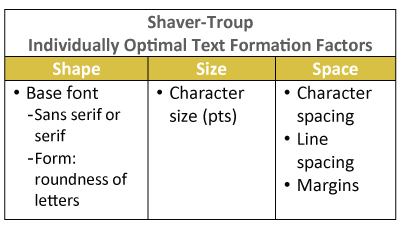Optimizing Reading Performance by Manipulating the Shape, Size, and Spacing of Text to Match the Individual’s Visual Processing Capacity
Bonnie Shaver-Troup, Kathy Crowley, Marjorie Jordan
Published by the Collective Impact Project, revReading, September 2017
The ability to read quickly and efficiently is essential in the digital world with the exponential proliferation of information. Yet, reading problems are and have been a significant issue in the United States for more than five decades. According to the U.S. Department of Education, nearly 7 in 10 students of any age are non-proficient readers, and will remain so throughout their lifetime.[1]
This inability to read well will affect individuals in school and later as adults in the job market and everyday life.[2] The pervasiveness of this issue is often misunderstood, frequently perceived only as an issue for those with significant reading struggles. Research reveals the true impact is across the continuum of good to poor readers. These issues are found in classrooms and boardrooms[3] with symptoms ranging from significant reading issues to eye strain or blurred vision.
Reading problems are pervasive across age, gender, and socioeconomic status with real long-term costs.[4] The financial cost of reading issues for the U.S. is billions of dollars, globally it is trillions and rising every day.[5]
Reading and Typography
Proficient reading is a rapid process. Character recognition must occur in nanoseconds; any interruption can impede the process.[6] Every typographical factor of text plays a critical role in creating a successful reading experience.[7] A vision and reading researcher explains:
There are parts of the visual system that are sensitive to patterns not occurring in nature, but that our culture and people have created over time…If that’s the case, studies may lead to solutions toward customizing text….[8]
Historical principles and norms of typeface and typographical design remain relatively unchanged. Whether hardcopy or electronic medium, publishers continue to deliver text in a single, publisher-selected typeface or font. This one-format-fits-all offering does not allow for the unique needs of the reader.
Solution Development
As an educational therapist, in 1999, Bonnie Shaver-Troup observed that reading issues masked the individual’s true capability and intelligence. Shaver-Troup theorized that these issues were a sensitivity to typographical factors. She began manipulating multiple text factors, specifically facets of shape, size and spacing to find a match between text format and an individual’s optimized visual processing capabilities.
In 2000, Shaver-Troup theorized that performance would improve through use of (1) hyper expansion of character spacing, which creates a greater lag time and reduces potential crowding and masking effects, (2) expanded scaling, and (3) a sans-serif font to reduce noise. Applying an evidence-based, user-engaged design model, she identified a continuum of needs. This led to the development of six formulations that alter a text format, creating an immediate improvement in reading performance.[9]
 In clinical practice with both children and adults, Shaver-Troup used a simple fluency test* to measure the effectiveness of the solution. Test results supported her theory; making the modifications to text format allowed the reader to instantaneously improve accurate reading speed, which research correlates to increased comprehension.[10] The solution does not require additional time or training. This fluency effect is instantaneous.
In clinical practice with both children and adults, Shaver-Troup used a simple fluency test* to measure the effectiveness of the solution. Test results supported her theory; making the modifications to text format allowed the reader to instantaneously improve accurate reading speed, which research correlates to increased comprehension.[10] The solution does not require additional time or training. This fluency effect is instantaneous.
Recent classroom data[11] has shown immediate improvement in an individual’s fluency, supporting Shaver-Troup’s early clinical and study results.[12] In these latest studies, most students, 95%, fell into 2 categories: those impacted most by the relatively simple change to a base font with better readability characteristics, and those impacted most by more significant changes.[13]
More significant text modifications produce the largest impacts for early readers and for the most text sensitive at any age; these individuals have been shown to increase accurate reading speed by 25-50%. The six formulations created a significant gain for the most text sensitive readers, and offer a starting place for better text delivery. Importantly, further customizations can and should be made for the unique needs of individuals.
* Fluency is defined as the ability to read with speed, accuracy, and proper expression. In order to understand what they read, readers must be able to read fluently whether they are reading aloud or silently. When reading aloud, fluent readers read in phrases and add intonation appropriately. (ReadingRocket.com) A fluency test measures number of correct words per minute read.
revReading
In 2015, revReading was formed to improve reading outcomes for all. As cited, previous research has shown typographic factors impact reading. Bonnie Shaver-Troup’s text solutions make it easy to start the individual optimization process. But the problem remains, stakeholders are not yet embracing the importance of differences and using the information to support individualized reading formats.
revReading’s goals are to: ensure that Shaver-Troup’s research and solution are known, promote technological development facilitating ease of implementation of the full set of text modifications, and invite additional research. With the extensive availability of technology, reading material should never again be limited to a one-format-fits-all solution. revReading is committed to building a future where all reading material is available in a format optimized for the individual.
Currently, anyone interested can use manual processes within a word processor to modify text shape, size and spacing factors to recreate one of the six formulations, or to create a custom format. In the future, revReading envisions:
- Electronic reader functionality that allows the reader to control shape (the base font and further expansion of the characters), text size, and character and line spacing, saving their optimal configuration and using it to be the most effective reader they can be.
- Websites with any significant quantity of text incorporate methods of individual optimization. While not yet developed, this might occur based on a user profile and text tagging. It may require text containers that can scroll independently, allowing space for the reader to change character shape, size and spacing.
- All electronically published text is live text, (rather than pictures of text,) enabling text reformatting.
In short, revReading plans to revolutionize reading.
Call to Action
Today readers of all ages are bombarded with more and more visual information. Research supports considering typographical factors as a method to improve reading performance. With the prevalence of digital technology, it is timely to consider how typographical factors might be used to enhance reading performance; specifically, how personalized customizations of shape, size and spacing might be used to create an individually optimal text format.
revReading seeks partners in technology, publishing and education. They share this knowledge and insight with the purpose of making written information more accessible to all. revReading encourages: educators and researchers to collaborate, publishers to support user-defined formats, and technology providers to expand personalization features. Further, once the technology is available, revReading encourages educators to expand individualized instruction to include individualized text formats. Together we can enable the best possible reading experiences rather than force suboptimal experiences; together we can revolutionize reading.
_______________________________
© Copyright 2017 revReading. The information contained herein is subject to change without notice. revReading shall not be liable for technical or editorial errors or omissions contained herein.
2017.S1.1, September 2017, Rev. 1
[1] https://www.nationsreportcard.gov/reading_math_2015/#reading?grade=4, retrieved 30 August 2017
[2] Ritchie, S. J., & Bates, T. C. (2013). Enduring links from childhood mathematics and reading achievement to adult socioeconomic status. Psychological Science, 24(7), 1301-1308. doi:10.1177/0956797612466268
http://www.aecf.org/resources/early-warning-why-reading-by-the-end-of-third-grade-matters/, retrieved 30 August 2017
[3] http://fortune.com/2015/10/15/business-leaders-dyslexia/, retrieved 30 August 2017
https://www.insidehighered.com/news/2013/10/08/us-adults-rank-below-average-global-survey-basic-education-skills#ixzz2pSf0jtfW, retrieved 30 August 2017
[4] http://www.huffingtonpost.com/2013/09/06/illiteracy-rate_n_3880355.html, retrieved 30 August 2017
[5] https://mic.com/articles/23873/illiteracy-costs-the-global-economy-1-trillion#.uiXNvqasW, retrieved 30 August 2017
[6] Bernard, J.B., & Chung, S.T.L. (2011). The dependence of crowding on flanker complexity and target–flanker similarity. Journal of Vision. 11(8): 1; doi:10.1167/11.8.1
Hughes, L & Wilkins, A. (2000). Typography in children’s reading schemes may be suboptimal: Evidence from measures of reading rate. Journal of Research in Reading. 23(3), 314-324.
Legge G. E. & Bigelow C. A. (2011). Does print size matter for reading? A review of findings from vision science and typography. Journal of Vision. 11(5). 8. doi:10.1167/11.5.8
Levi, D. M., Song, S., & Pelli, D. G. (2007). Amblyopic reading is crowded. Journal of Vision, 7(2):21, 1–17, http://journalofvision.org/7/2/21/, doi:10.1167/7.2.21
Martelli, M., Di Filippo, G., Spinelli, D., & Zoccolotti, P. (2009). Crowding, reading, and developmental dyslexia. Journal of Vision, 9(4), 1–18. doi:10.1167/9.4.14
Moret-Tatay, C. & Perea, M. (2011). Do serifs provide an advantage in the recognition of written words? Journal of Cognitive Psychology, 23(5), 619-624. doi:10.1080/20445911.2011.546781
O’Brien, B.A., Mansfield, S.J., & Legge, G.E. (2005). The effect of print size on reading speed in dyslexia. Journal of Research in Reading, 28(3), 332-349. doi:10.1111/j.1467-9817.2005.00273.x
Zoccolotti, P., De Luca, M., Marinelli, C. V., & Spinelli, D. (2014). Modeling individual differences in text reading fluency: a different pattern of predictors for typically developing and dyslexic readers. Frontiers in Psychology, 5, 1374. http://doi.org/10.3389/fpsyg.2014.01374
[7] DeLamater, W. E. (2010). How larger font size impacts reading and the implications for educational use of digital text readers. eReadia, Retrieved from http://www.ereadia.com/research/How_Larger_Font_Size_Affects_Reading.pdf
Tavakoli, E., & Kheirzadeh, S. (2011). The Effect of Font Size on Reading Comprehension Skills: Scanning for Key Words and Reading for General Idea. Theory And Practice In Language Studies, 1(7), 915-919. doi:10.4304/tpls.1.7.915-919
Pelli, D. G., Burns, C. W., Farell, B., & Moore-Page, D. C. (2006). Feature detection and letter identification. Vision Research, 464646-4674. doi:10.1016/j.visres.2006.04.023
[8] https://www.cmc.edu/news/new-study-to-eye-reading-discomfort, retrieved 30 August 2017
[9] Shaver-Troup, B., U.S. Patent Application No. 10/462,865, Publication No. US20040253568 A1 (published Dec. 16, 2004).
[10] Basaran, M. (2013). Reading fluency as an indicator of reading comprehension. Educational Sciences: Theory & Practice, 13(4). 2287-2290. doi: 10.12738/estp.2013.4.1922
Mellard, D. F., Fall, E. E., & Woods, K. L. (2013). Relation and interactions among reading fluency and competence for adult education learners. Learning Disabilities Research & Practice: A Publication of the Division for Learning Disabilities, Council for Exceptional Children, 28(2), 70–80. doi.org/10.1111/ldrp.12008
[11] revReading. (2015). The reading performance of 3rd graders: Does font matter? Unpublished raw data.
[12] Shaver-Troup, B. (2004). The effect of print style on the reading performance of students with dyslexia. Unpublished raw data.




